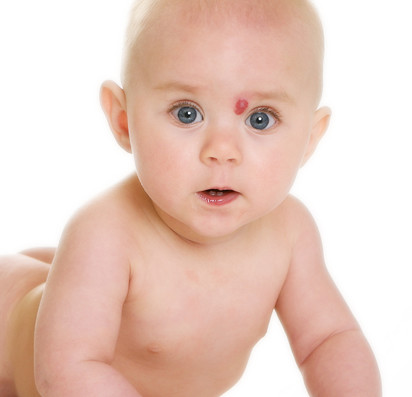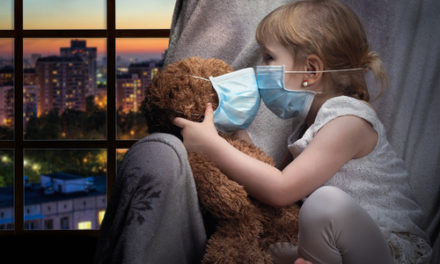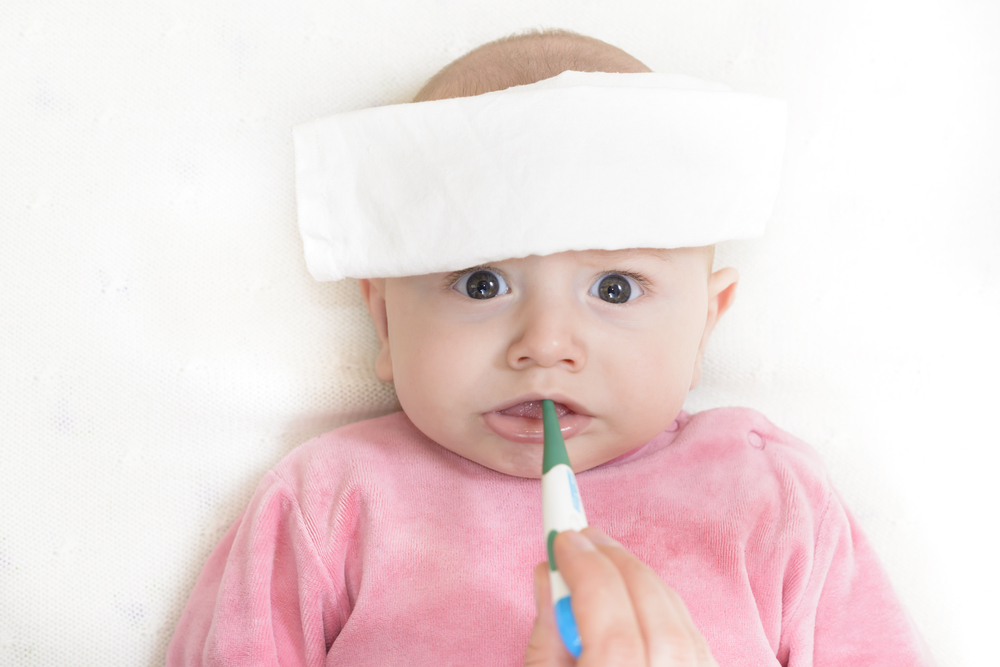Have you been surprised to find a new spot on your child and wondered where it came from?
The word “birthmark” is really misleading. They can be present at birth, but they don’t have to be. Birthmarks often appear when a child gets older and demonstrate that a baby’s body is still developing. Like the rest of their body, babies’ skin pigmentation is not mature at birth. Most kids get a little darker all over as they get older. What’s really funny is that a newborn boy’s scrotum can be much darker than the rest of the body and will eventually darken to match. (A light-skinned newborn has surprised a few darker-skinned new dads.)
The word “birthmark” is a catchall name used to describe pretty much every mark on the body. The term refers to overgrowth of any kind of cell on the skin. For example, an overgrowth of blood vessels makes a different birthmark than an overgrowth of pigmented cells. I’ll explain in this colorful guide to kids’ spots:
Blue Spots
Mongolian spots are one of the true birthmarks – they appear at birth and go away. They are uniquely blue in color and are usually located on the low back or butt. They get their color from brown melanin pigment, it just appears blue because the pigment is buried in a deeper layer of the skin. Skin gets essentially all of its color from melanin that is located in the top layer of skin (the epidermis). When the same melanin pigment lies deeper in the skin (the deeper ‘dermis’ layer) it takes on a blue-gray hue to the human eye.
How does melanin get deeper in the skin?
Melanocytes are the melanin-producing cells and they actually come from a group of cells that pinch off when the neural tube is formed. The neural tube goes on to become the spinal cord and the melanocytes actually migrate from the neural crest to the skin while the baby is still in the womb. Some melanocytes don’t make it all the way to the epidermis and get stuck in the deeper dermis layer creating these blue patches on a baby’s bottom that look a lot like bruises.
Red Spots
Red birthmarks are all related to blood vessels misbehaving. The ultra fascinating red marks called “strawberry” hemangiomas are made from a bunch of cells that are supposed to line the inside of capillaries, but instead they are hanging out on the skin looking at cute girls. Hemangiomas typically appear in the first few weeks of life and grow very rapidly. They can grow to be quite large before they fade and leave behind a faint mark.
Other classic red marks are the stork bite and angel’s kiss. Legend says these are the spots where the stork carried the baby by the neck or an angel kissed the forehead. And there isn’t really a better scientific explanation, though researchers speculate that they are caused by the normal blood vessels in the forehead and neck opening wider than normal. The nerves that control these blood vessels aren’t yet developed enough to signal the vessels to constrict, so they have more blood flow and look more red under the skin. As the baby’s nervous system develops, the vessels will begin to constrict down and will no longer appear so bright. As the forehead and neck skin get thicker as the baby gets older you won’t see the blood vessels so easily. At least, that is, until your teenager comes home drunk and the angel’s kiss will light up like an alarm. Pretty useful birthmark.
Brown Spots
Moles, freckles and other brown spots reveal themselves after a baby starts going out in the sun. When skin is exposed to sunlight (ultraviolet radiation), melanocytes are activated and shuttle melanin out to shield the skin cells, protecting their DNA from damage.
Café au lait spots are one of the more common brown birthmarks. These spots are areas of the skin where the individual melanocyte cells make more melanin than other melanocytes. So they look like flat areas of skin that are a uniform tan-brown color. They grow in proportion to the growing body and don’t change much throughout life.
When you start to notice birthmarks or freckles appear, you know your baby is being exposed to UV radiation in sunlight.
Other areas of the skin have melanocytes that make a normal amount of melanin, but there are a whole lot more of these pigment-producing cells clustered together. They can cluster in different ways and at varying depths in the skin creating a variety of unique beauty marks and moles.
Besides giving you character, moles can serve other purposes. In traditional Chinese culture experts can “read” facial moles to determine lucky or unlucky faces. In medieval Europe, birthmarks represented entry points of the devil into the soul and, in modern times, some people believe they are marks from past lives. The majority of cultures have legends that suggest birthmarks are a manifestation of the pregnant mother’s unsatisfied wishes. So if mom wants pickles and she doesn’t get them, the baby will be marked accordingly. The truth is that birthmarks simply reflect our natural human variation…and also remind us that we need to use sunscreen.
Wondering how to choose the right sunscreen for children? Read The Sunscreen Scoop: recommendations for every age
References
Hypermelanoses of the newborn and of the infant. Dermatol Clin. 2007 Jul;25(3):327-36, viii. Taïeb A1, Boralevi F.










Birthmarks are common and usually harmless. But some may require treatment for cosmetic reasons or because of rapid growth. Still others may be a sign of an underlying disease.